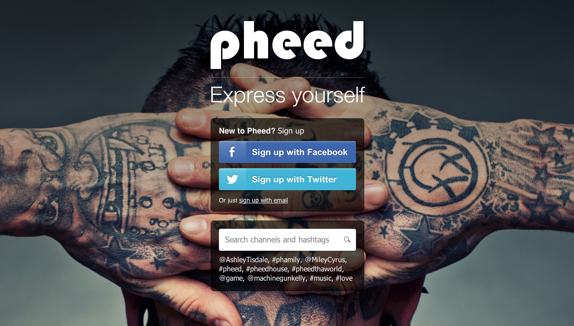It’s “Twitter with a business plan.” It’s “the ultimate ‘mashup’ of other (social media) sites.” It’s Pheed. Social media’s newest addition, launched in October 2012, is getting hashtags flying and controversy stirring (more on that later)—so, what’s this newcomer all about?

A “mashup” of social media, as CEO/cofounder O.D. Kobo calls it, is a pretty accurate description of Pheed. Featuring a timeline similar to Facebook, trending topics as seen on Twitter, and the ability to follow other users, Pheed is not much different than undeniable muses Twitter, Facebook, Instagram.. the list goes on. Users, known as “Pheeders” (a bit macabre, if you ask us), can share video and audio content, live broadcasts, and photos with their followers on Pheed and other social networks. Pheeders can like, dislike, or bookmark content from their circle of fellow users and receive updates in real-time or based on various topics.
Here’s where things start to get a little interesting. All of your content, from photos to video broadcasts, can be monetized. Users are able to select a monthly subscription fee ranging from $1.99 to $34.99, or a pay-per-view option within the same price range. Pheed takes 50% of the earnings; users take home the other half. Pheeders can also assign their channels a rating (think MPAA) so young eyes aren’t exposed to R-rated escapades (which could be an inherent problem for the social network). Although monetizing your account is just an option, it’s certainly piqued the interest of celebrities like Chris Brown, David Guetta, Miley Cyrus, and Paris Hilton; seeking a new way to connect with their fans and well… sell themselves. “What social media is today is about selling bits and pieces of people’s lives. It’s not necessarily selling that one song, it’s selling access to me,” Kobo recently told Fast Company.
Since its launch, Pheed has already snagged over a million users. For a network less than two months old, these numbers, and the celebrity backers that go along with them, are impressive. However, Pheed has already had its fair share of problems. Much like any Facebook/Twitter alternative, Pheed is set up to allow users to register and log in through the two social media superpowers. But on October 19, Twitter disconnected the functionality allowing Pheeders to log in through the microblog. Twitter privileges were quietly re-established just three days later.
Although it’s conceivable Twitter pulled the plug after hearing about a call to arms for a Twitter vs. Pheed battle royale—many have insinuated Twitter’s lack of innovation gave Pheed life in the first place—API violations are the likely story. Pheeders voiced concern and complaints (on Twitter) over the new network’s habit of auto-tweeting quite a bit on users’ behalf. The outcry caused Pheed to trend on Twitter, but not under a positive light.
Pheed is in no way alone in taking certain liberties with its users’ Twitter accounts, but so many complaints so soon after launch do not bode well for the newbie. While the monetization options Pheed offers are interesting and unique to the social sphere thus far, it’s difficult to say whether users beyond celebrities (aspiring or actual) will take a fancy to that functionality—and, in turn, difficult to say whether Pheed will stay afloat. Furthermore, even if an unknown singer chooses to sell a living room performance, it doesn’t mean anyone will buy it, leaving both Pheed and the artist high and dry. If Pheed enhanced its monetization benefits by helping its users promote their content to draw a larger audience, using the feature would be a win-win.
But that still leaves the rest of the Pheeders who aren’t singers, photographers, filmmakers, and so on. If the network were to add more robust features not focused on sales—think enhanced photo sharing that stands out from Instagram or engagement options beyond the standard “like”— it could quickly build up more universal appeal. However, until that day comes, Pheed’s draw seems to begin and end with its exhibition factor—which still isn’t fully developed—and doesn’t offer much we haven’t seen before, many times over. What do you think of Pheed—next big thing or a flash in the pan?
Sources
Chaey, Christina. “Pheed Launches A Social Network That Feels Like A Mash-Up Of Every Social Network You Use .” FastCompany.com . N.p., 12 Oct. 2012. Web. 26 Oct. 2012. <http://www.fastcompany.com/3002107/pheed-launches-social-network-feels-mash-every-social-network-you-use>.
Lunden, Ingrid. “Is Twitter Starving Pheed? New Social Network Says Its Twitter Connect Got Cut Off.” TechCrunch. N.p., 19 Oct. 2012. Web. 26 Oct. 2012. <http://techcrunch.com/2012/10/19/is-twitter-starving-pheed-new-social-network-says-its-twitter-connect-got-cut-off/>.
Panzarino, Matthew. “Pheed loses its Twitter privileges, very likely because it was vomiting tweets all over the place.” The Next Web: Apps. N.p., 20 Oct. 2012. Web. 26 Oct. 2012. <http://thenextweb.com/apps/2012/10/20/pheed-loses-its-twitter-privileges-very-likely-because-it-was-vomiting-tweets-all-over-the-place/>.
Pozin, Ilya. “Is Pheed the New Twitter? .” Forbes.com. N.p., 18 Oct. 2012. Web. 26 Oct. 2012. <http://www.forbes.com/sites/ilyapozin/2012/10/18/is-pheed-the-new-twitter/>.
Prakash, Neha. “Pheed Wants to Take On the Giants of Social Media.” Mashable. N.p., 22 Oct. 2012. Web. 26 Oct. 2012. <http://mashable.com/2012/10/22/pheed/>.
Tam, Donna. “Twitter restores connection for hot new social startup Pheed.” CNET. N.p., 22 Oct. 2012. Web. 23 Oct. 2012. <http://news.cnet.com/8301-1023_3-57537470-93/twitter-restores-connection-for-hot-new-social-startup-pheed/>.